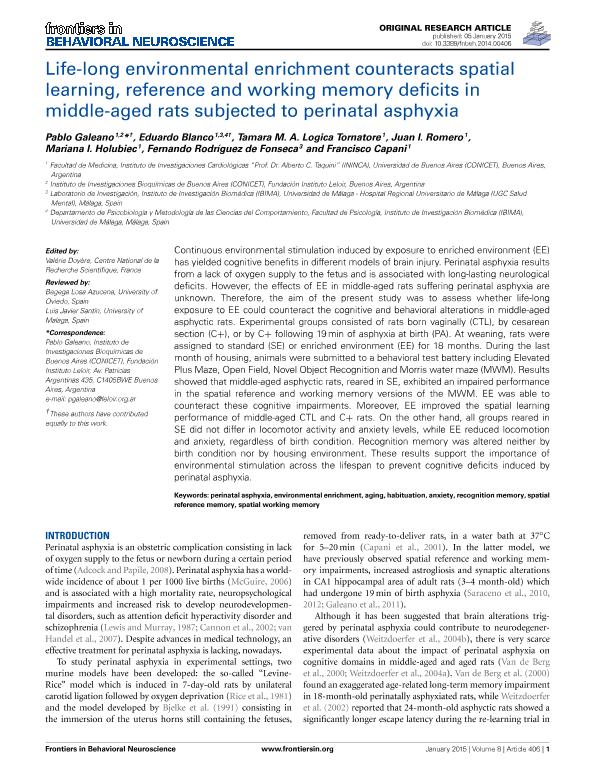Mostrar el registro sencillo del ítem
dc.contributor.author
Galeano, Pablo

dc.contributor.author
Blanco, Eduardo
dc.contributor.author
Logica Tornatore, Tamara Maite Ayelén

dc.contributor.author
Romero, Juan Ignacio

dc.contributor.author
Holubiec, Mariana Ines

dc.contributor.author
Rodríguez de Fonseca, Fernando
dc.contributor.author
Capani, Francisco

dc.date.available
2016-11-24T20:13:57Z
dc.date.issued
2015-01
dc.identifier.citation
Galeano, Pablo; Blanco, Eduardo; Logica Tornatore, Tamara Maite Ayelén; Romero, Juan Ignacio; Holubiec, Mariana Ines; et al.; Life-long environmental enrichment counteracts spatial learning, reference and working memory deficits in middle-aged rats subjected to perinatal asphyxia; Frontiers In Bioscience Inc; Frontiers in Behavioral Neuroscience; 8; 406; 1-2015; 1-12
dc.identifier.issn
1662-5153
dc.identifier.uri
http://hdl.handle.net/11336/8378
dc.description.abstract
Continuous environmental stimulation induced by exposure to enriched environment (EE) has yielded cognitive benefits in different models of brain injury. Perinatal asphyxia results from a lack of oxygen supply to the fetus and is associated with long lasting neurological deficits. However, the effects of EE in middle aged rats suffering perinatal asphyxia are unknown. Therefore, the aim of the present study was to assess whether life long exposure to EE could counteract the cognitive and behavioral alterations in middle aged asphyctic rats. Experimental groups consisted of rats born vaginally (CTL), by cesarean section (C+), or by C+ following 19 min of asphyxia at birth (PA). At weaning, rats were assigned to standard (SE) or enriched environment (EE) for 18 months. During the last month of housing, animals were submitted to a behavioral test battery including Elevated Plus Maze, Open Field, Novel Object Recognition and Morris water maze (MWM). Results showed that middle aged asphyctic rats, reared in SE, exhibited an impaired performance in the spatial reference and working memory versions of the MWM. EE was able to counteract these cognitive impairments. Moreover, EE improved the spatial learning performance of middle aged CTL and C+ rats. On the other hand, all groups reared in SE did not differ in locomotor activity and anxiety levels, while EE reduced locomotion and anxiety, regardless of birth condition. Recognition memory was altered neither by birth condition nor by housing environment. These results support the importance of environmental stimulation across the lifespan to prevent cognitive deficits induced by perinatal asphyxia.
dc.format
application/pdf
dc.language.iso
eng
dc.publisher
Frontiers In Bioscience Inc

dc.rights
info:eu-repo/semantics/openAccess
dc.rights.uri
https://creativecommons.org/licenses/by-nc-sa/2.5/ar/
dc.subject
Perinatal Asphyxia
dc.subject
Environmental Enrichment
dc.subject
Aging
dc.subject
Habituation
dc.subject
Anxiety
dc.subject
Recognition Memory
dc.subject
Spatial
dc.subject
Reference Memory
dc.subject
Spatial Working Memory
dc.subject.classification
Neurociencias

dc.subject.classification
Medicina Básica

dc.subject.classification
CIENCIAS MÉDICAS Y DE LA SALUD

dc.title
Life-long environmental enrichment counteracts spatial learning, reference and working memory deficits in middle-aged rats subjected to perinatal asphyxia
dc.type
info:eu-repo/semantics/article
dc.type
info:ar-repo/semantics/artículo
dc.type
info:eu-repo/semantics/publishedVersion
dc.date.updated
2016-08-30T17:12:26Z
dc.journal.volume
8
dc.journal.number
406
dc.journal.pagination
1-12
dc.journal.pais
Suiza

dc.journal.ciudad
Lausana
dc.description.fil
Fil: Galeano, Pablo. Consejo Nacional de Investigaciones Científicas y Técnicas. Oficina de Coordinación Administrativa Parque Centenario. Instituto de Investigaciones Bioquimicas de Buenos Aires; Argentina. Consejo Nacional de Investigaciones Científicas y Técnicas. Oficina de Coordinación Administrativa Houssay. Instituto de Investigaciones Cardiológicas (i); Argentina
dc.description.fil
Fil: Blanco, Eduardo. Consejo Nacional de Investigaciones Científicas y Técnicas. Oficina de Coordinación Administrativa Parque Centenario. Instituto de Investigaciones Bioquimicas de Buenos Aires; Argentina. Instituto de Investigaciones Bioquímicas de Málaga; España. Universidad de Malaga; España
dc.description.fil
Fil: Logica Tornatore, Tamara Maite Ayelén. Consejo Nacional de Investigaciones Científicas y Técnicas. Oficina de Coordinación Administrativa Houssay. Instituto de Investigaciones Cardiológicas (i); Argentina
dc.description.fil
Fil: Romero, Juan Ignacio. Consejo Nacional de Investigaciones Científicas y Técnicas. Oficina de Coordinación Administrativa Houssay. Instituto de Investigaciones Cardiológicas (i); Argentina
dc.description.fil
Fil: Holubiec, Mariana Ines. Consejo Nacional de Investigaciones Científicas y Técnicas. Oficina de Coordinación Administrativa Houssay. Instituto de Investigaciones Cardiológicas (i); Argentina
dc.description.fil
Fil: Rodríguez de Fonseca, Fernando. Universidad de Malaga; España
dc.description.fil
Fil: Capani, Francisco. Consejo Nacional de Investigaciones Científicas y Técnicas. Oficina de Coordinación Administrativa Houssay. Instituto de Investigaciones Cardiológicas (i); Argentina
dc.journal.title
Frontiers in Behavioral Neuroscience
dc.relation.alternativeid
info:eu-repo/semantics/altIdentifier/url/http://journal.frontiersin.org/article/10.3389/fnbeh.2014.00406/abstract
dc.relation.alternativeid
info:eu-repo/semantics/altIdentifier/doi/http://dx.doi.org/10.3389/fnbeh.2014.00406
Archivos asociados
